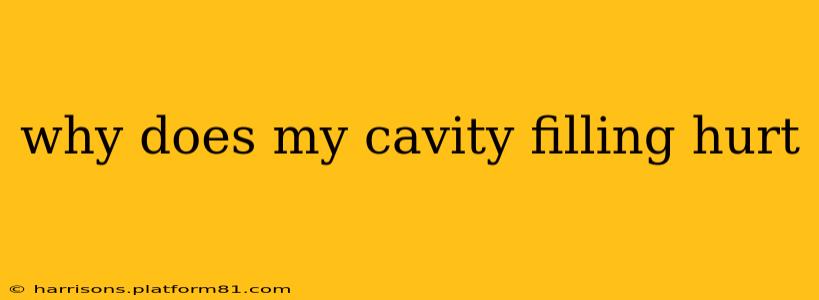A tooth filling is a common dental procedure designed to repair decayed teeth and prevent further damage. While fillings are generally effective, some patients experience pain or discomfort afterward. Understanding the potential causes of this post-filling pain is crucial for managing expectations and seeking appropriate treatment. This comprehensive guide will explore the various reasons why your cavity filling might be hurting and what you can do about it.
What are the Common Causes of Pain After a Filling?
Several factors can contribute to post-filling pain. Let's explore some of the most common reasons:
1. Irritation of the Tooth's Nerve: Even with careful procedures, the filling process can sometimes irritate the tooth's sensitive pulp (nerve). This irritation can cause a mild to moderate ache, often described as a throbbing or sharp pain. The pain usually subsides within a few days as the nerve settles down.
2. Too High Filling: If the filling material is placed too high, it can interfere with your bite and put excessive pressure on the tooth. This can lead to intense pain, particularly when biting down. This is a crucial point to address immediately with your dentist as it can lead to further complications.
3. Infection or Inflammation: While less common, infection or inflammation around the filling site is possible. This can manifest as persistent, throbbing pain, potentially accompanied by swelling or sensitivity to hot or cold temperatures.
4. Gum Irritation: The filling procedure might inadvertently irritate the surrounding gums. This can lead to soreness and tenderness in the area. This is typically a temporary issue that resolves within a few days.
5. Sensitivity to Temperature Changes: Some people experience increased sensitivity to hot or cold foods and drinks after a filling, due to the exposure of the dentin (the layer beneath the enamel). This sensitivity usually fades as the tooth adapts.
How Long Should Post-Filling Pain Last?
Mild discomfort or sensitivity after a filling is expected and usually resolves within a few days. However, if the pain is severe, persistent, or worsening, it's essential to contact your dentist. The pain should not be debilitating and should improve gradually. Prolonged pain could signify a more serious issue requiring professional attention.
What Should I Do if My Filling Hurts?
- Contact your dentist: If you experience severe, persistent, or worsening pain, don't hesitate to contact your dentist. They can assess the situation, diagnose the problem, and provide appropriate treatment.
- Over-the-counter pain relievers: For mild discomfort, over-the-counter pain relievers like ibuprofen or acetaminophen can help manage the pain. Always follow the recommended dosage instructions.
- Avoid biting down hard: If the filling feels high or is causing pressure, avoid biting hard on that side of your mouth to minimize irritation.
- Good oral hygiene: Maintain excellent oral hygiene practices, including brushing and flossing regularly, to promote healing and prevent infection.
Is Post-Filling Pain a Sign of a Bad Filling?
Not necessarily. While post-filling pain can sometimes indicate a problem with the filling (like being placed too high), many other factors can also cause discomfort. A thorough evaluation by your dentist is necessary to determine the underlying cause of the pain and if the filling needs adjustment or replacement.
When Should I See a Dentist About Post-Filling Pain?
Seek immediate dental attention if:
- The pain is severe or unbearable.
- The pain is persistent and doesn't improve after a few days.
- You experience swelling or redness around the filling.
- You notice a foul taste or odor coming from the affected area.
Addressing post-filling pain promptly is crucial for ensuring the success of the filling and maintaining the health of your tooth. Open communication with your dentist is key to resolving any issues and ensuring your overall dental well-being. Don't hesitate to reach out with any concerns – they are there to help!
